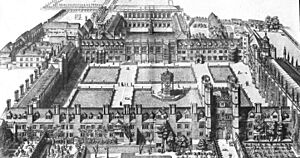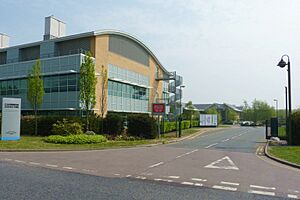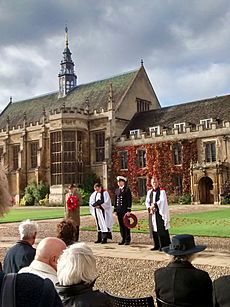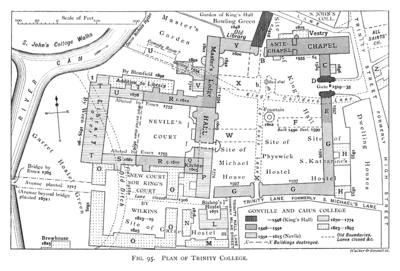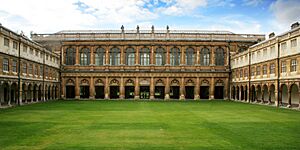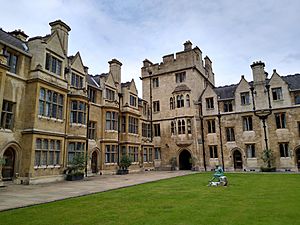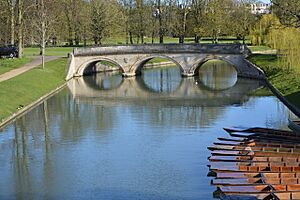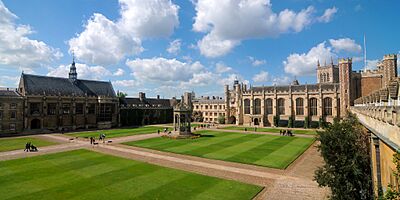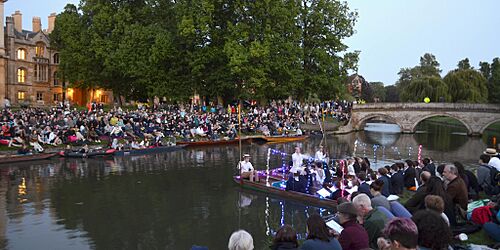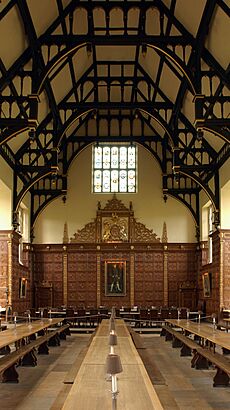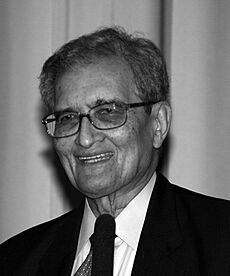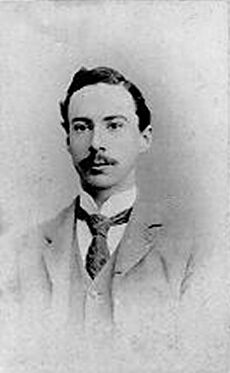Trinity College, Cambridge facts for kids
Quick facts for kids Trinity College |
||||||||||||
|---|---|---|---|---|---|---|---|---|---|---|---|---|
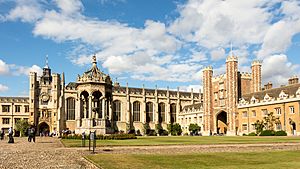
Trinity College Great Court
|
||||||||||||
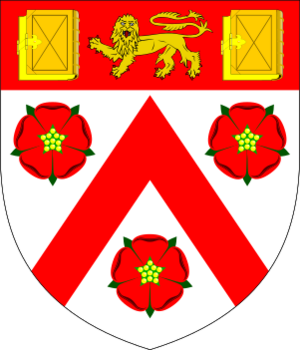
Coat of arms of Trinity College
Blazon: Argent, a chevron between three roses gules barbed and seeded proper and on a chief gules a lion passant gardant between two closed books all Or |
||||||||||||
| University | University of Cambridge | |||||||||||
| Location | Trinity Street (map) | |||||||||||
| Full name | The College of the Holy and Undivided Trinity within the Town and University of Cambridge of King Henry the Eighth's Foundation | |||||||||||
| Latin name | Collegium Trinitatis | |||||||||||
| Motto | Virtus Vera Nobilitas (Latin) | |||||||||||
| Motto in English | Virtue is true nobility | |||||||||||
| Founder | Henry VIII of England | |||||||||||
| Established | 1546 | |||||||||||
| Named after | The Holy Trinity | |||||||||||
| Previous names | King's Hall and Michaelhouse (until merged in 1546) | |||||||||||
| Sister college | Christ Church, Oxford | |||||||||||
| Master | Dame Sally Davies | |||||||||||
| Undergraduates | 735 (2022-23) | |||||||||||
| Postgraduates | 336 (2022-23) | |||||||||||
| Senior tutor | Professor Catherine Barnard | |||||||||||
| Map | ||||||||||||
| Lua error in Module:Location_map at line 420: attempt to index field 'wikibase' (a nil value). | ||||||||||||
Trinity College is a famous college at the University of Cambridge in England. It was started in 1546 by King Henry VIII. Trinity is one of the biggest colleges in Cambridge. It also has the largest amount of money saved up compared to any other college at Oxbridge (Oxford and Cambridge).
Trinity College is known for its excellent academic results. It often ranks as the top college in the Tompkins Table, which is a list of how well Cambridge colleges perform in exams. From 2011 to 2017, Trinity was number one. In 2020–21, it had the highest percentage of students getting top grades.
Many people from Trinity have won important awards. These include 34 Nobel Prizes, four Fields Medals (for maths), one Turing Award (for computing), and one Abel Prize (also for maths). Six British prime ministers and two members of the British royal family have studied here. Trinity is also the largest college at Oxbridge by student numbers, with about 730 undergraduate students, 300 graduate students, and 180 teachers (called fellows).
Trinity has many student groups. These include the Trinity Mathematical Society, which is the oldest maths club at a UK university. The First and Third Trinity Boat Club is its rowing club. This club even gives its name to the college's big party, the May Ball. Trinity also helped create the first rules for Association football (soccer) in 1848. Trinity's sister college is Christ Church, Oxford.
Contents
History of Trinity College
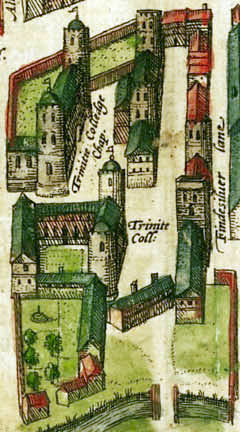
How Trinity College Started
King Henry VIII founded Trinity College in 1546. He combined two older colleges, Michaelhouse (started in 1324) and King's Hall (started in 1317). At that time, King Henry was taking land from churches. Universities like Cambridge were worried they might be next.
The universities asked the King's wife, Catherine Parr, for help. She convinced him not to close them. Instead, he decided to create a new, large college. He didn't want to use his own money. So, he merged Michaelhouse and King's Hall, plus seven smaller student houses, to form Trinity.
Building the College: Nevile's Work
Trinity College grew a lot under its Master, Thomas Nevile (1593–1615). He rebuilt and redesigned much of the college. This included making the Great Court bigger and finishing it. He also built Nevile's Court between Great Court and the river.
Nevile's Court was finished later with the Wren Library. This famous library was designed by Christopher Wren. Nevile's building projects were very expensive. The college was in debt for many years because of them.
Trinity College Today
In the 20th century, Trinity College was a key place for the Cambridge Apostles. This was a special, secret group for smart thinkers. Trinity is the richest college at Oxbridge. Its land alone is worth about £800 million.
Trinity College owns some very important places. These include:
- Housing at the Port of Felixstowe, which is a very busy port.
- The Cambridge Science Park, a place for science and technology companies.
- The O2 Arena in London, a large entertainment venue.
College Stories
It is said that Lord Byron, a famous poet, kept a pet bear when he lived at Trinity. Trinity is also often said to be the place where "Trinity burnt cream" was invented. This is an English version of crème brûlée.
Trinity in Camberwell
Trinity College has a long connection with a church in South London called St George's, Camberwell. Since 1966, students from Trinity have helped run holiday activities for children from that area. This connection became a formal charity called Trinity in Camberwell in 1979.
Buildings and Grounds
Great Gate
The Great Gate is the main entrance to Trinity College. It leads into the Great Court. Above the door, there is a statue of the college's founder, Henry VIII. In 2023, the college put a sceptre in the statue's hand. This was to celebrate the 75th birthday of Charles III, who studied at Trinity.
Great Court
Great Court was built between 1599 and 1608. It was the idea of Thomas Nevile. He knocked down many old buildings to create this large space. The Master's Lodge, where the head of the college lives, is also here. It is the official home for the King or Queen when they visit Cambridge.
Nevile's Court
Nevile's Court was built in 1614. It is located between Great Court and the river. This court was made possible by a gift from Thomas Nevile. It was later extended and finished with the famous Wren Library.
The Wren Library (built 1676–1695) was designed by Christopher Wren. It is one of Cambridge's most famous libraries. It holds many important items. These include two of Shakespeare's First Folios and letters written by Isaac Newton.
New Court
New Court (built 1825) is south of Nevile's Court. It is known for the large tree in its middle. There is a story that this was the tree where an apple fell on Isaac Newton. But Newton was at home when he thought of gravity. Also, the tree is a horse chestnut, not an apple tree.
Other College Areas
Whewell's Court (1860–1868) is across the street from Great Court. It was paid for by William Whewell, a former Master of the college. Angel Court (built 1957–1959) and the Wolfson Building (built 1968–1972) are used for first-year students. Blue Boar Court (built 1989) and Burrell's Field (built 1995) are also part of the college.
Chapel
The Trinity College Chapel was built in the mid-16th century. It is a very important historical building. Inside, you can find memorials to people who were part of Trinity. One famous statue is of Isaac Newton, made by Louis-François Roubiliac. The college choir performs in the Chapel.
Grounds
Trinity College has several gardens and sports fields. The Fellows' Garden is a nice green space. The Fellows' Bowling Green is used for parties in the summer. The Old Fields have the college gym, squash courts, and pitches for rugby, hockey, and football.
Trinity Bridge
Trinity Bridge is a stone bridge over the River Cam. It was built in 1765. It is also a very important historical building.
Academic Success
Trinity College has a very strong academic record. For the past twenty years, it has always been among the top colleges in the Tompkins Table. This table ranks Cambridge colleges by how well their students do in exams. Trinity has been in first place for the last six times. In 2016, 45% of Trinity students got the highest possible grade. This was a record for Cambridge colleges.
Becoming a Student
Getting into Trinity College is very competitive. This is because of its history, strong academics, and famous former students. Trinity states that it chooses students only based on their academic potential. It does not consider what type of school they attended. Trinity welcomed its first female graduate student in 1976 and its first female undergraduate in 1978.
Scholarships and Awards
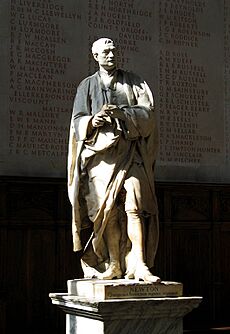
Trinity College offers scholarships and prizes to its students.
- Research Scholars get money for their advanced studies. They are usually top students who continue studying at Trinity.
- Senior Scholars are undergraduates who get top grades after their first year. They receive a yearly payment and can choose their rooms first.
- Junior Scholars are students who get top grades in their first year. They also receive a yearly payment.
All students who get a top grade in their exams also receive an extra prize. The college also helps many final-year students pay for master's degrees. Only Fellows (teachers) and their guests can walk on the grass in the college courts. Scholars can walk on the Scholars' Lawn, but only when wearing their special academic gowns.
College Traditions
The Great Court Run
The Great Court Run is a famous challenge at Trinity. Students try to run around the 400-yard edge of Great Court. They must do this in the 43 seconds it takes for the clock to strike 12. It is a very difficult run.
The run was shown in the movie Chariots of Fire. In the movie, the run was filmed at a different college. For many years, new students would try the run at midnight after a special dinner. Now, the college holds a more formal Great Court Run at noon. Some students run seriously, while others wear fun costumes. Prizes are given for the fastest man and woman.
Outdoor Concerts
One Sunday in June, the College Choir performs a short concert. It is called Singing from the Towers. Half of the choir sings from the Great Gate, and the other half sings from the Clock Tower. This creates a cool echo effect.
Later that day, the choir performs another outdoor concert. This one is called Singing on the River. They sing songs from a raft of punts on the river. The punts are lit with lanterns. For the last song, the raft floats away, making the music slowly fade out.
The Mallard Duck
Another tradition involves a fake duck called the Mallard. It is supposed to stay in the high beams of the Great Hall. Students used to move the duck from one beam to another without permission. This was very hard to do because the beams are so high. In 2006, a pigeon knocked it down. Students put it back in 2016.
College Rivalry
Trinity College has a friendly rivalry with St John's College. They often compete in sports and academics. There are many stories about this rivalry. One story says that the clock in Trinity's Great Court strikes each hour twice because St John's once complained about the noise.
Other Small Traditions
Trinity College students wear dark blue gowns with black trim. Most other Cambridge colleges wear black gowns. Students wear these gowns for formal events, like special dinners. Trinity students are also among the first to be presented at graduation ceremonies.
College Prayer
Each evening before dinner, a special prayer, called a grace, is said. It is spoken in Latin. It asks for blessings on the food and thanks for the gifts received. After the meal, a short Latin phrase is said to give thanks.
People from Trinity College
Famous Fellows and Alumni
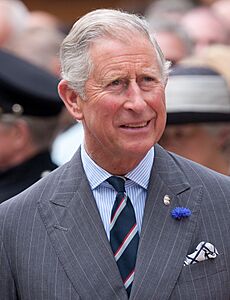
Many famous people have studied or taught at Trinity College. King Charles III studied here from 1967 to 1970. Marian Hobson was the first woman to become a Fellow (teacher) at the college in 1977. Her picture hangs in the college hall. Other notable female Fellows include Catherine Barnard and Dame Sally Davies, the current Master.
Nobel Prize Winners
Trinity College has had many Nobel Prize winners. Here are some of them:
| Name | Field | Year |
|---|---|---|
| John Strutt, 3rd Baron Rayleigh | Physics | 1904 |
| Joseph John (J. J.) Thomson | Physics | 1906 |
| Ernest Rutherford | Chemistry | 1908 |
| William Bragg | Physics | 1915 |
| Lawrence Bragg | Physics | 1915 |
| Charles Glover Barkla | Physics | 1917 |
| Niels Bohr | Physics | 1922 |
| Francis William Aston | Chemistry | 1922 |
| Archibald V. Hill | Physiology or Medicine | 1922 |
| Austen Chamberlain | Peace | 1925 |
| Owen Willans Richardson | Physics | 1928 |
| Frederick Hopkins | Physiology or Medicine | 1929 |
| Edgar Douglas Adrian | Physiology or Medicine | 1932 |
| Henry Dale | Physiology or Medicine | 1936 |
| George Paget Thomson | Physics | 1937 |
| Bertrand Russell | Literature | 1950 |
| Ernest Walton | Physics | 1951 |
| Richard Synge | Chemistry | 1952 |
| John Kendrew | Chemistry | 1962 |
| Alan Hodgkin | Physiology or Medicine | 1963 |
| Andrew Huxley | Physiology or Medicine | 1963 |
| Brian David Josephson | Physics | 1973 |
| Martin Ryle | Physics | 1974 |
| James Meade | Economic Sciences | 1977 |
| Pyotr Kapitsa | Physics | 1978 |
| Walter Gilbert | Chemistry | 1980 |
| Aaron Klug | Chemistry | 1982 |
| Subrahmanyan Chandrasekhar | Physics | 1983 |
| James Mirrlees | Economic Sciences | 1996 |
| John Pople | Chemistry | 1998 |
| Amartya Sen | Economic Sciences | 1998 |
| Venkatraman Ramakrishnan | Chemistry | 2009 |
| Sir Gregory Paul Winter | Chemistry | 2018 |
| Didier Queloz | Physics | 2019 |
Fields Medallists
Four people from Trinity College have won the Fields Medal, a top award in mathematics.
| Name | Year |
|---|---|
| Michael Atiyah | 1966 |
| Alan Baker | 1970 |
| Richard Borcherds | 1998 |
| Timothy Gowers | 1998 |
Turing Award Winners
| Name | Year |
|---|---|
| James H. Wilkinson | 1970 |
British Prime Ministers
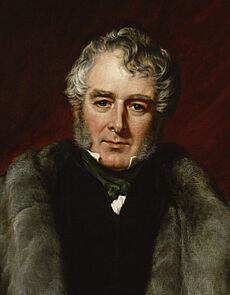
Six British Prime Ministers studied at Trinity College.
| Name | Party | Year |
|---|---|---|
| Spencer Perceval | Tory | 1809–1812 |
| Charles Grey, 2nd Earl Grey | Whig | 1830–1834 |
| William Lamb, 2nd Viscount Melbourne | Whig | 1834–1841 |
| Arthur Balfour | Conservative | 1902–1905 |
| Henry Campbell-Bannerman | Liberal | 1905–1908 |
| Stanley Baldwin | Conservative | 1923–1924 1924–1929 1935–1937 |
Other important politicians from Trinity include Jawaharlal Nehru, the first Prime Minister of India, and Rajiv Gandhi, another Prime Minister of India.
Masters of Trinity College
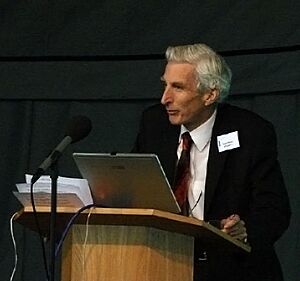
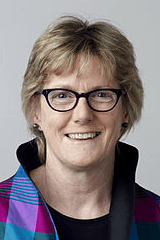
The person in charge of Trinity College is called the Master. The King or Queen formally appoints the Master. The college's teachers (fellows) suggest who should be the new Master. The first Master was John Redman in 1546. The current Master, Dame Sally Davies, started in 2019. She is the first female Master of Trinity College.
Images for kids
-
The River Cam as it flows past the back of Trinity, Trinity Bridge is visible and the punt house is to the right of the moored punts.
See also
 In Spanish: Trinity College (Cambridge) para niños
In Spanish: Trinity College (Cambridge) para niños
- Isaac Newton Institute for Mathematical Sciences, partially funded by Trinity


